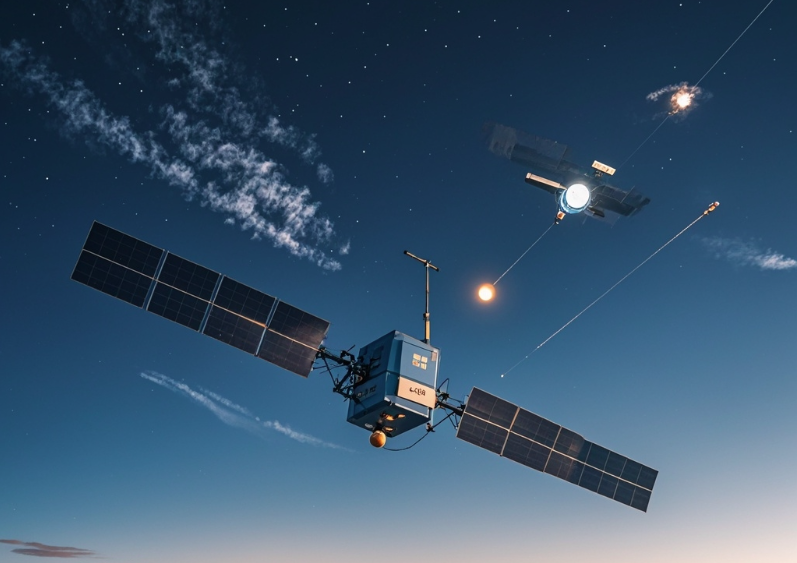The Beidou system integrates Beidou short message communication with the characteristics of mixed constellations and system advantages to achieve integrated communication and navigation. The Beidou system exclusively achieves short message function and communication integration through active positioning RDSS. The Beidou short message SMS service is divided into SMS services provided to users in the Asia Pacific region and SMS services provided to users worldwide. The regional SMS adopts the RDSS system, and users cannot independently complete distance calculation. They need to send positioning requests and information to GEO satellites, which forward them to the ground center. The ground center completes the user's position calculation and transmits the position and related information back to the user through the satellite. RDSS adopts an active system with limited user capacity, and Beidou-3 has significantly expanded the regional SMS service capacity. When a handheld terminal sends a short message, the current location information can be simultaneously sent to the platform or other terminals, and the platform and terminal can parse or display the sender's latitude and longitude.

The process of sending short messages is as follows:
1) The short message sender first encrypts the communication request signal containing the receiver's ID number and communication content, and forwards it to the station via satellite;
2) After receiving the communication request signal, the ground center station adds it to the continuously broadcasted outbound broadcast message after decryption and re encryption, and broadcasts it to users via satellite;
3) The receiving user machine receives the outbound signal, demodulates and decrypts the outbound message, and completes one communication. The transmission delay of short message communication is about 0.5 seconds, and the highest frequency of communication is also once per second.
Generalized RDSS system: The user machine receives RDSS and RNSS1 signals broadcasted by a GEO satellite, as well as RNSS2 signals from at least one MEO or IGSO satellite. The user machine measures the time difference between RNSS2 and RNSS1 signals, and then sends this parameter to the control station through GEO satellites. The main control station can use these parameters to calculate the user's machine position and perform bidirectional timing. The user machine can communicate with the main control station in both directions through GEO satellites.
RNSS+message communication system: using RNSS signals from the Beidou Navigation Constellation for user position calculation and one-way timing; Utilize the bidirectional data transmission capability of only one GEO satellite for bidirectional message communication. By using more RNSS signals for position calculation and timing, the accuracy is higher and it can adapt to high dynamic users. In addition, there is no need for bidirectional interaction between the user machine and the control station for user location calculation, which to some extent releases system capacity.
The short message service capability of Beidou-3 has been significantly enhanced. The Beidou-3 regional short message utilizes GEO satellites for communication services, with a maximum length of up to 14000 bits per message and approximately 1000 Chinese characters. The global short message communication service utilizes 14 MEO satellites to achieve global coverage of message communication services. The maximum length of a single short message is 560 bits, which is approximately equivalent to 40 Chinese characters.
The transmission power of short message terminals in the Beidou-3 area has been reduced to below 3W; The success rate of regional short message communication is better than 99.6%, and the success rate of global short message communication is better than 96.46%.
Beidou Short Message System has strong anti-interference ability, fast response, and high cost-effectiveness, making it very suitable for applications such as emergency communication and search and rescue. Compared to traditional mobile communication methods, the Beidou-3 short message system has advantages such as high reliability, wide coverage, and low cost. Especially in remote areas or disaster situations, it can better ensure the security and stability of communication. By using Beidou short messages, users can input SMS content on their mobile phones or other terminal devices in places without cellular networks, and achieve global SMS sending and receiving through the Beidou-3 satellite. This enables mass mobile phone satellite ground fusion communication without changing cards, numbers, or adding peripherals. The Beidou-3 short message system can not only be used for daily communication and emergency rescue, but also applied in fields such as transportation, fisheries, forestry, meteorology, and geological exploration, to achieve positioning, tracking, and monitoring of objects, vehicles, animals, and plants. In addition, the Beidou-3 short message system also supports the transmission of various data types, including voice, image, etc.
Prev:How does a tri band signal service satellite navigation system compare to dual band GPS
Next:Working principle of electronic fence, UWB electronic fence
Copyrights© Shenzhen Skylab Co.,LTD All Rights Reserved.

